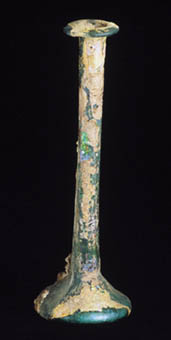|
Introduction
Many Roman glass vessels appear to shimmer with
color like a peacock's tail; others, at first glance, look as if
they are covered with patches of gold foil. Neither of these effects
were deliberately produced by a Roman glassworker. Instead they
result from a gradual weathering that glass undergoes when it is
buried for a long period in damp soil.
|
|

Unguentarium with
chalky soil encrustation
1st century A.D.
Ht., 18.5 cm
|
REFERENCES
1) Brill, R.H., 1963: "Ancient Glass,"
Scientific American 209:5, 120-131.
2) Fleming, S.J., 1999: Roman Glass:
Reflections on Cultural Change, Appendix A (University of Pennsylvania
Museum, Philadelphia).
3) Kaplan, M.F. and Mendel, J.E., 1982: "Ancient
Glass and the Safe Disposal of Nuclear Waste," Archaeology
35:4, 22-29.
4) Isard,
J.O., 1986: "Influence of Alkaline Earth Ions on the Corrosion
of Glasses," Physics and Chemistry of Glasses 27:2,
55-58.
|

